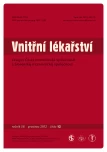Is antiplatelet therapy always effective?
Authors:
A. Remková 1; A. Janušicová 1; M. Remko 1,2
Authors‘ workplace:
Centrum hemostázy a trombózy, HemoMedika Bratislava, Slovenská republika, vedúca centra prof. MUDr. Anna Remková, DrSc.
1; Farmaceutická fakulta Univerzity Komenského, Bratislava, Slovenská republika, dekan prof. PharmDr. Ján Kyselovič, CSc.
2
Published in:
Vnitř Lék 2012; 58(12): 904-914
Category:
Original Contributions
Overview
Objective:
Acetylsalicylic acid (ASA) and clopidogrel (KLP) therapy is associated with the high degree of variability in response to the drug and some patients are drug-resistant. The aim of our study was to evaluate the individual response to antiplatelet therapy in patients at high risk of cardiovascular events treated with ASA (n = 131), KLP (n = 51) or ASA + KLP (n = 34).
Subjects and methods:
Investigations were performed in them by light transmission aggregometry and in selected patients by VASP fosforylation.
Results:
Good response to ASA treatment with arachidonic acid-induced platelet aggregation inhibition < 20% reached 75.0% of patients, partial response with 20–40% inhibition 12.9% of patients and poor response with > 40 % inhibition 12.1 % of patients. Good response to KLP treatment with 20 µmol/l ADP-induced platelet aggregation inhibition < 60% reached 66.1% of patients, partial response with 60–70% inhibition 13.9% of patients and poor response > 70% in 20% of patients. In patients treated by KLP + ADP induced platelet aggregation correlated with VASP fosforylation. We found, that 50% of KLP-treated and 44.4% of ASA-treated patients obtained the adequate response to therapy by compliance improvement. In 80% of patients, which did not respond to KLP therapy in daily dose of 75 mg, the adequate response after the increase to daily dose of 150 mg was observed. The increase of ASA daily dose above 100 mg did not improve in our patients their response to therapy. However, in those patients without a good response to low-dose ASA (< 100 mg daily) the increase to daily dose of 100 mg effectively influenced the aggregatory response.
Conclusion:
Laboratory monitoring of individual response allows the optimalization of the antiplatelet therapy. The patients who could profit from other type of antiplatelet therapy, such as prasugrel and ticagrelor, can be selected by this method.
Key words:
acetylsalicylic acid – clopidogrel – antiplatelet therapy – light transmission aggregometry (LTA)
Sources
1. Yeung J, Holinstat M. Newer agents in antiplatelet therapy: a review. J Blood Med 2012; 3 : 33–42.
2. Pecka M, Malý J. Metabolické a aktivační děje v krevních destičkách a možnosti jejich inhibice. Vnitř Lék 2009; 55 : 263–266.
3. Pecka M (ed.). Praktická hematologie. Laboratorní metody. Český Těšín: Infiniti art 2010 : 343 s.
4. Remková A, Janušicová A, Šujanová Z et al. Máme monitorovať protidoštičkovú liečbu? Lek Obz 2011; 60 : 131–135.
5. Bonello L, Tantry US, Marcucci R et al. Consensus and future directions on the definition of high on-treatment platelet reactivity to adenosine diphosphate. J Am Coll Cardiol 2010; 56 : 919–933.
6. Chen WH, Lee PY, Ng W, Tse HF, Lau CP. Aspirin resistance is associated with a high incidence of myonecrosis after non-urgent percutaneous coronary intervention despite clopidogrel pretreatment. J Am Coll Cardiol 2004; 43 : 1122–1126.
7. Mega JL, Close SL, Wiviott SD et al. Cytochrome P-450 Polymorphisms and Response to Clopidogrel. New Engl J Med 2009; 360 : 354–362.
8. Collet JP, Hulot JS, Pena A et al. Cytochrome P450 2C19 polymorphism in young patients treated with clopidogrel after myocardial infarction: a cohort study. Lancet 2009; 373 : 309–317.
9. Wallentin L, Becker RC, Budaj A et al. PLATO Investigators. Ticagrelor versus clopidogrel in patients with acute coronary syndromes. N Engl J Med 2009; 361 : 1045–1057.
10. Graham I, Atar D, Borch-Johnsen K et al. European Guidelines on Cardiovascular Disease Prevention: Fourth Joint European Societies´ Task Force on Cardiovascular Disease Prevention in Clinical Practice. Executive Summary. Eur Heart J 2007; 28 : 2375–2414.
11. Breet NJ, van Werkum JW, Bouman HJ et al. High on-aspirin platelet reactivity as measured with aggregation-based, cyclooxygenase-1 inhibition sensitive platelet function tests is associated with the occurrence of atherothrombotic events. J Thromb Haemost 2010; 8 : 2140–2148.
12. Breet NJ, van Werkum JW, Bouman HJ et al. Do not adjust the platelet count in light transmittance aggregometry when predicting thrombotic events after percutaneous coronary intervention. J Thromb Haemost 2010; 8 : 2326–2328.
13. Cattaneo M. Response variability to clopidogrel: is tailored treatment, based on laboratory testing, the right solution? J Thromb Haemost 2012; 10 : 327–336.
14. Wang XD, Zhang DF, Liu XB et al. Modified clopidogrel loading dose according to platelet reactivity monitoring in patients carrying ABCB1 variant alleles in patients with clopidogrel resistance. Eur J Intern Med 2012; 23 : 48–53.
15. Campo G, Parrinello G, Ferraresi P et al. Prospective evaluation of on-clopidogrel platelet reactivity over time in patients treated with percutaneous coronary intervention relationship with gene polymorphisms and clinical outcome. J Am Coll Cardiol 2011; 57 : 2474–2483.
16. Pecháň J, Mikulecký M, Okrucká A. Circadian rhythm of plasma β-thromboglobulin in healthy human subjects. Blood Coagul Fibrinolysis 1992; 3 : 105–107.
17. Jeong YH, Bliden KP, Tantry US, Gurbel PA. High on-treatment platelet reactivity assessed by various platelet function tests: is the consensus-defined cut-off of VASP-P platelet reactivity index too low? J Thromb Haemost 2012; 10 : 487–489.
18. Price MJ, Angiolillo DJ, Teirstein PS et al. Platelet reactivity and cardiovascular outcomes after percutaneous coronary intervention: a time-dependent analysis of the Gauging Responsiveness with a VerifyNow P2Y12 assay: impact on thrombosis and safety (GRAVITAS) trial. Circulation 2011; 124 : 1132–1137.
Labels
Diabetology Endocrinology Internal medicineArticle was published in
Internal Medicine

2012 Issue 12
Most read in this issue
- Arterial hypertension in gravidity – a risk factor for cardiovascular diseases
- Current opinions on gout, its diagnosis and treatment
- Current guidelines on the care of tunelized vascular catheters in patients on home parenteral nutrition
- Is antiplatelet therapy always effective?
